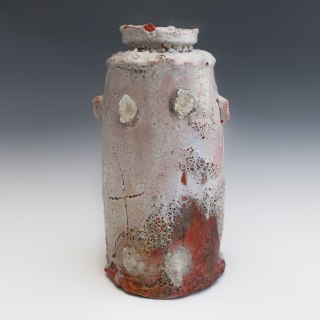
Lacoste/Keane Gallery is pleased to announce its May exhibition featuring international ceramic artists Shozo Michikawa from Japan and Hans Vangsø from Denmark. This exhibition highlights the vessel form as interpreted from two points of view with the point of convergence being simplicity, an aesthetic both countries share.
Shozo Michikawa (b.1953) is a ceramic artist who shows at art fairs and solo and group exhibitions in countries such as France, Germany, Belgium, UK, USA and the Philippines. Michikawa makes works that are thrown at the wheel at first and manipulated with a twist on an internal axis to transform into sculptural vessels. Although the vessel is his foundation, he often finds inspiration in nature which is evident in his technique of tearing and glazing mimicking rocks and natural stones. Firmly rooted in Japanese pottery tradition, he insists that pottery is “integral to people’s lives in Japan” and his works are respectful to this principle with a contemporary spin.
Hans Vangsø (b.1950) was the trusted long-time assistant of the late Danish potter Gutte Eriksen (1918-2008). Eriksen was recognized for influencing a generation of studio potters through her work and teachings at Jutland Academy of Fine Arts, Arhus. Vangsø achieved international recognition in his own right and has shown at art galleries in Denmark, UK, Belgium, Japan and the USA. His works are influenced by Japanese pottery, yet the surfaces on his vessels are unique. Bubbles and blisters on the surfaces layered with thick glazes are achieved by firing the works in paper saggar with salt, seaweed and metal. The colors are subtle, for example, a black vessel might reveal a tinge of red, yet the rustic markings appear to have gone through some form of geological stress.
This exhibition brings together two aesthetic which contrast yet find common ground in their visual language. Michikawa and Vangsø, work within the rigor of the studio pottery tradition yet with the expressiveness of sculpture. They have a close friendship for many years with Vangsø invited as a guest artist at the 2017 International Ceramics Art Festival in Sasama organized by Michikawa. Lacoste/Keane Gallery is pleased to have Michikawa and Vangsø show together for the first time.
SHOZO MICHIKAWA
Shozo Michikawa was born in Hokkaido, the most northern area of Japan, in 1953. After graduating from Aoyama Gakuin University in 1975, he settled in Seto, Aichi to establish his ceramic studio. His exhibitions are held widely in Japan and also internationally, such as Philippines, Mongolia, France, USA, and UK. He is a finalist in the 2019 Loewe Craft Prize.
Michikawa is inspired by the power and energy of nature in its every form. He makes works that are thrown at the wheel at first and manipulated with a twist on an internal axis to transform into sculptural vessels. Firmly rooted in Japanese pottery tradition, he insists that pottery is “integral to people’s lives in Japan” and his works are respectful to this principle with a contemporary spin.
HANS VANGSØ
Hans Vangsø works within a Scandinavian tradition of bold simplicity. He studied at Jutland Academy of Fine Arts in Denmark and was taught by the noted Gutte Eriksen, one of the great originators of Danish studio ceramics, and his mentor. Through her, Vangsø also became inspired by the Japanese ceramic tradition, the roots and soul of ceramics. The combination of great simplicity in form and rich texture in glazes, and above all, the total melting of glaze and body render his work unique. The very much alive surfaces of the glaze are obtained in the firing methods developed over years and years, as each piece is fired several times in a gas kiln with salt, seaweed, and metals.